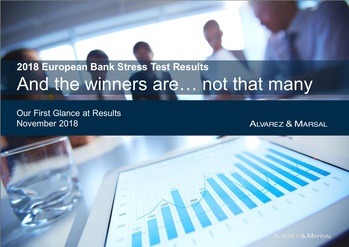Are European Banks really in good shape? European Banking Authority Stress Test results 2018
Stress Test 2018 results are out after a year-long process – At first glance, results are good for large European banks as no incremental capital needs, are identified and most banks demonstrate strong resilience to weather a stress test. However, a detailed analysis of results shows that there are more losers than winners as most banks are unable to fit their business models to generate adequate levels of efficiency and returns within the new regulatory constraints. Financial markets already discount survival of the fittest.
Stress test results help us to understand three things;
- Capital Needs: Vulnerability of banks to adverse scenarios and potential capital needs under stress. While capital depletion measured in terms of CET 1 transitional impact increased from last EBA stress test from 380bps to 410bps in average, no incremental bank capital needs are required as all banks finish at acceptable capital levels after stress.
- Capital Flexibility: Capacity to distribute capital in the form of dividends and stock repurchases. Stress test results do not influence minimum SREP requirements and as a result do not trigger explicit restrictions on dividend or AT1 coupon payments. However, because starting capital levels have improved, banks display greater flexibility to distribute capital. Buffer over minimum threshold of 5.5% has improved from 390bps to 480bps.
- Peer Comparison: Benchmark analysis of capital and performance indicators across countries and banks. Worst performing countries measured in terms of post stress CET1 fully loaded are UK, Spain, Austria and Italy and best are Sweden, Finland, Poland and Norway.
While the test displays strong capital results and improved capital flexibility, it also evidences important performance gaps. These are our four key takeaways from the EBA Stress Test 2018 results:
- Lagging Profitability: Only 3 banks of the 48 banks analyzed show ROE above cost of capital under the 2016-18 baseline scenario and no bank adds shareholder value under the adverse scenario. This explains why banks trade at 0.75 times book value and show the need for further restructuring of prices, cost and business models.
- Declining margins: Staggered credit volumes together with declining rate environment explain declining margins from 2% in 2016 to 1.8% in 2018 test.
- Banks continue to display low efficiency: While every bank is working on transforming business models and client experiences, efficiency ratio is projected at 65% well above the 45% level that the sector should aspire to.
- Large Stock of Non-Productive Assets: NPL ratio has improved from 2016 levels from 5% to 3.9% of the tested sample (with countries like Italy (10.3 per cent)) and Ireland (10.5 per cent) that contrast with US (less than 2 per cent). European banks should continue with their unwinding of non-productive assets as they generate high operating, funding and capital costs while constraining new credit.
What was different this year?
The supervisory process - European stress tests included provisioning under IFRS 9 for the first time. As expected IFRS9 introduces an acceleration of credit losses in a crisis. The introduction of IFRS 9 made the tests to run for a year. This was too long. ECB timing, process and tools can be improved. By the time the results are out, the world has changed, and scenarios become less relevant. For instance, spreads on Italian sovereign bonds have widened during the last two months at twice the shock considered in the EBA stress test. More importantly, stress test impacts in Europe are less than those produced by comparable exercises run by UK and US regulators. By contrast to the US and UK, stress tests do not have teeth in Europe as are not a binding constraint for banks. This is important as the harshness of US tests have contributed to bank strength and as a result have foster economic credit growth (+10 per cent in the last quarter vs +1 per cent in EU).
Conclusion
While there is welcome good news on the capital front, 2018 stress test results continue to show an industry that struggles to perform under new regulatory constraints. Bank performance scorecards show major efficiency and profitability gaps that explain lagging stock price valuations.
In summary, a healthy capitalised banking system in Europe that can weather stresses but that fails to meet investor demands for higher returns. The market discounts today that only the fittest banks will survive.
But what steps can bank take to better prepare themselves for next time?
- Improve business profitability by applying stricter capital allocation and pricing
- Selling unprofitable businesses and concentrating on core activities that drive acceptable returns
- Restructure business model to arrive at efficiency levels of 45%
- Finalise NPL unwinding
Our recent report into the 2018 EBA Stress Test, we set out our in-depth analysis of the results, including on a country-specific and individual bank level.





